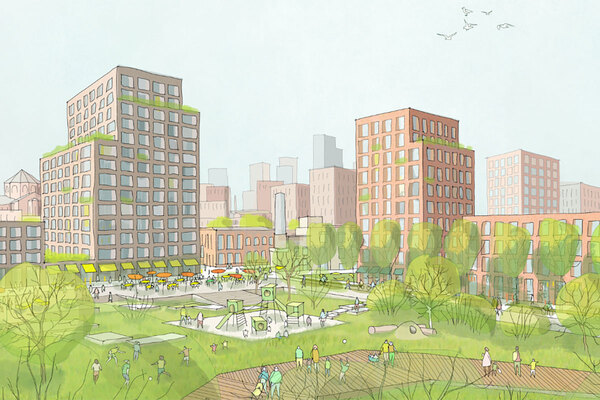UK fuel poverty: a cool summer affects results
In the fourth Housing Fuel Poverty Index update of 2024, Inside Housing looks at the numbers reported by Switchee’s smart thermostats to help track fuel poverty across the UK
In association with:
![]()
There was a slight rise in fuel poverty in social homes across the UK in summer 2024 compared to the previous year, according to the latest data from smart thermostat provider Switchee.
Switchee’s Fuel Poverty Index, the data from which is shared exclusively with Inside Housing, uses smart devices installed in social rented homes to track fuel poverty in real time, with homes failing to reach 18°C
in any seven-day period deemed to be in fuel poverty.
Using this metric, the latest data shows that from June to August 2024, an average of just 0.32% of social homes were in fuel poverty, up from 0.24% in 2023. With far fewer homes failing to reach 18°C during the warmer months, these figures are much lower than in previous quarters. The small increase is likely to be partly because summer 2024 was more than 1°C cooler on average than 2023, and even down on the 30-year average for the UK.
“We generally see low levels of fuel poverty during summer due to favourable weather conditions, and that trend has continued this summer,” says Ben Morris, data lead at Switchee. “However, while these levels are low, they are not zero. Through June to August this year, the average Fuel Poverty Index levels were 0.3%. While as a proportion it is small, it still equates to 15,000 social homes in the UK, and we should therefore be mindful that this issue hasn’t gone away and action is required.”
5.74%
Rate of fuel poverty over the year in the North East
0.32%
Average percentage of homes in fuel poverty from June to August 2024
With these figures added to those gathered in previous quarters, we can see more clearly how the UK’s fuel poverty levels have changed over a year. From September 2023 to the end of August 2024, an average of 4.43% of social homes were in fuel poverty in the UK, more than a quarter fewer than during the same time frame in 2022-23, when an average of 5.98% of homes failed to hit the 18°C threshold over a seven-day period.
It means that, while nearly one in 17 households were in fuel poverty on average on any given day in 2022-23, fewer than one in 23 households were in the same position during the same period in 2023-24.
“This trend is perhaps not surprising given the sharp falls in the energy price cap ahead of October 2023, along with a slightly milder winter,” Mr Morris says. “However it is not all good news, as fuel poverty levels are still higher than two winters previously, partly as a result of large rises in the levels of consumer energy debt that exist in the UK as a result of prolonged high energy prices. Ofgem data shows that total consumer debt and arrears has jumped to £3.3bn – almost double levels seen prior to the first big price rise in April 2022.”
Across the regions
The UK-wide reduction in fuel poverty across the 12 months to the end of August 2024 is matched in Scotland, where an average of 4.65% of social homes were fuel-poor, compared with 6.16% in 2022-23.
In Wales, where more homes have been assessed as fuel-poor according to Switchee’s methodology, the drop-off is more pronounced. From September 2023 to August 2024, 5.76% of homes in the sector failed to reach 18°C on average in any seven-day period, but in the equivalent period the previous year, this figure reached 9.22%. Wales’ rate of fuel poverty for the three months to September was slightly below the national figure, coming in at an average of 0.29%. Scotland’s rate, meanwhile, was significantly higher at 0.51%.
Looking at regions in England, the figures for the summer months all show lower levels of fuel poverty, as to be expected given the warmer weather. In trying to establish a picture of trends in fuel poverty, however, it is more instructive to again look at the 12-month period, for which comparative data is now available.
The highest rates of fuel poverty over the year in England occurred in the North East (5.74%), the South West (5.7%) and the West Midlands (5.66%). However, all of these showed significant improvement on the previous 12 months. The West Midlands saw the greatest drop in homes in fuel poverty, with a 30% decrease, while the decrease in the South West was 27%.
In Greater London, only 2.96% of social homes were in fuel poverty over any seven days, making it the only region to fall below the 3% mark.
As more data emerges from Switchee, we hope to get a clearer picture of the national and regional trends.
Recent content in association with Switchee
CPD webinar on demand: fostering data-driven engagement with residents on fuel poverty
As part of Inside Housing’s CPD offering, watch the full webinar and earn CPD minutes
How can social landlords use data to tackle fuel poverty?
As we enter winter and fuel bills spike, half of social tenants cannot afford to heat their homes, but identifying who those tenants are remains a challenge. Here, sector leaders discuss how better use of data could fight energy poverty
UK fuel poverty: a cool summer affects results
In the fourth Housing Fuel Poverty Index update of 2024, Inside Housing looks at the numbers reported by Switchee’s smart thermostats to help track fuel poverty across the UK
CPD webinar on demand: how can social landlords assess whether retrofit is delivering intended performance improvements?
As part of Inside Housing’s CPD offering, watch the full webinar and earn CPD minutes
What do the latest fuel poverty stats tell us?
In the third Housing Fuel Poverty Index update of 2024, Inside Housing looks at the numbers reported by Switchee’s smart thermostats to help track fuel poverty across the UK
CPD module: how to approach decarbonisation policy and strategies
The policy environment on decarbonisation and retrofit is evolving, so how can social landlords continue to build strategies to meet net zero? Richard Ellis, director of sustainability at Peabody, explains in this CPD module
What will Awaab’s Law mean for landlords and residents?
An Inside Housing roundtable, in association with Switchee, discusses how incoming legislation will affect how landlords approach repairs and maintenance in their homes
Using data to deliver better services
How are landlords collecting data and using it to make decisions about asset management and meeting residents’ needs? An Inside Housing survey, with data analytics firm Switchee, finds out
Is fuel poverty on the decline?
The latest data from smart thermostat provider Switchee suggests that the fuel poverty crisis may be starting to ease. Inside Housing analyses the figures
The numbers behind fuel poverty in the UK
Switchee’s new model shows the number of social households underheating their homes across the UK in real time, during 2022 and 2023. Inside Housing looks into the figures
How can landlords help residents to save on energy bills?
Inside Housing speaks to Emma Bitting at Switchee to find out what residents can do to ensure their homes are warm, and how they can save money on bills
How landlords are using data to tackle fuel poverty
An Inside Housing roundtable, in association with Switchee, discusses how landlords can analyse data to ensure they are helping residents who are struggling with energy costs
Internet of Things devices start to make a difference
A national network of vetted installers means the industry can collaborate to provide landlords with invaluable insights, says Philip Taylor of Internet of Things device provider Switchee
Choosing smart data and tech can help landlords achieve Better Social Housing Review goals
Technology can help landlords in terms of their business and regulatory compliance, as well as improving residents’ quality of life and bringing down bills, explains Tom Robins of tech firm Switchee
Sign up for our asset management newsletter
Already have an account? Click here to manage your newsletters












